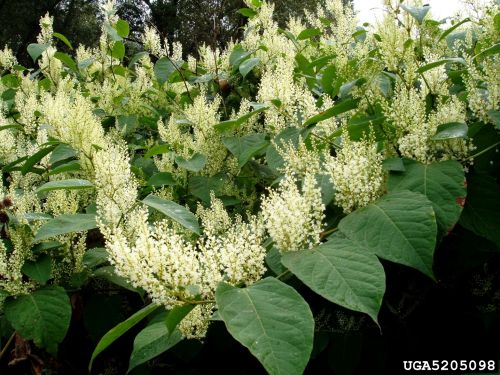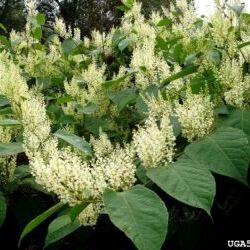
Priority: Contain
General: Aggressive and fast-growing plant resembling bamboo.
Height: Grows up to 3m tall.
Flowers: Flowers are a greenish white or pink. Each flower is approximately 2mm growing in clusters growing out of stem and leaf joints.
Leaves/Stems: Stems are very distinct resembling bamboo. They are hollow with red-brown flecks. Leaves are heart-shaped, dark green, 8-10cm wide, 15cm long. The leaves grow out of the stems alternatively.
Root: Creeping roots called rhizomes that are up to 7.5cm in diameter, reaches 20 wide in the soil and 3m deep. It is good to consider the root system like an iceberg. The root mass is extensive.
Bamboo, Donkey rhubarb, Asian knotweed
There are 4 types of knotweed: Japanese, Giant, Bohemian, Himalayan. They are often confused with ornamental bamboo (Bambusoideae spp.). Refer to the Metro Vancouver reference for detailed information.
Differences: Ornamental bamboo stems are very hard. Knotweed stems can be easily broken. Bamboo leaves are generally longer and very slender.
Where did it come from? Knotweed is native to Asia. It was introduced as a garden ornamental. In Lillooet, it was planted in gardens and property for hedges because it grows fast. It has been reported to require special care for it to establish but once established it is very hard to control.
Where does it grow here? Knotweeds prefer moist environments and thrives in regions like Metro Vancouver that is a temperate rainforest. It can tolerate a wide variety of conditions that include high heat, drought and shade. It grows along creeks, rivers and lakeshores (Seton Lake beach).
Reproduction: Spreads by roots (rhizomes) primarily. It can also spread by seed and stem fragments. Small amount of stem fragments can sprout new plants.
When does it grow, flower & seed? Sprouts April-July. Flowers August-September. Seeds October-November. These are very dependent on regions in BC.
Spreads By: Root, stem fragments and seeds can be transported in soil. Flooding events can move this plant. People can still purchase this plant for their gardens.
Plant Type: Perennial
- Can crack foundations and cause damage to houses & sidewalks.
- Infestations can crowd roadsides blocking sightlines on highways.
- Shorelines of creeks, rivers and lakes can be completely taken over by knotweed.
- Knotweed roots are extensive but not efficient at stabilizing soil. Knotweed infestations can actually increase soil washing away into water bodies during spring high water.
- Decreased water quality can impact fish spawning like salmon.
- It can take over gardens and easily take over natural ecosystems and plants. This can cause damage to the food and habitat of wildlife.
- Review your property regularly for this species. DO NOT plant anywhere.
- Treatment LRISS highly recommends that a certified professional be consulted for all removal projects. This plant can spread very easily and contaminated soil can cause new infestations. Refer to the Metro Vancouver Best Management document for some initial guidance. Very small infestations can be removed by digging (less than 2-3m square).
- Cover bare patches or disturbed soil by planting or seeding with non-invasives.
- Check areas where you have removed invasives for any new plants that year and in future growing seasons.
- Dispose of invasive plants responsibly. It is essential to bag this plant and soil for disposal at the local landfill. Composting and burning are not recommended.
- Contact LRISS for specific treatment recommendations.
Metro Vancouver and the Invasive Species Council of Metro Vancouver. Best Management Practices for Knotweed Species in the Metro Vancouver Region. May 2018.
